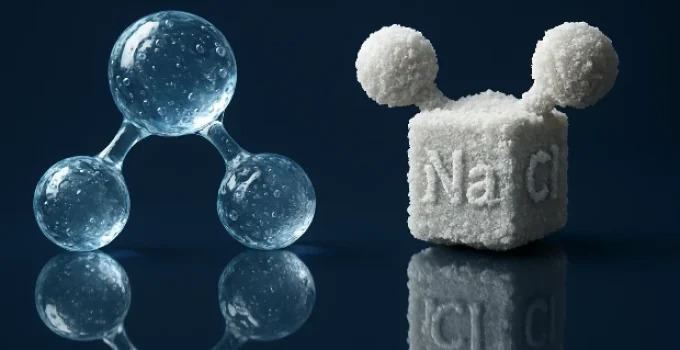What Are Ionic and Covalent Compounds?
✅ Answer:
Ionic and covalent compounds are two types of chemical compounds based on how atoms bond together. In ionic compounds, atoms transfer electrons, forming charged particles called ions. In covalent compounds, atoms share electrons to stay connected. These different bonds lead to different properties in each compound.
🧭 Dive Deeper:
- What Is a Chemical Bond?
- What Are Ionic Compounds?
- What Are Covalent Compounds?
- Key Differences Between Ionic and Covalent Compounds
- Examples of Each Type
- Why These Compounds Matter in Science
- 🎯 Final Thoughts
- 📚 References
What Is a Chemical Bond?
A chemical bond is what holds atoms together in a compound. Atoms form bonds to become more stable, often by filling up their outer shells of electrons.
There are two main types:
- Ionic bonds – atoms transfer electrons
- Covalent bonds – atoms share electrons
How they bond determines how the compound looks, feels, and behaves.
What Are Ionic Compounds?
Ionic compounds are formed when one atom gives away electrons to another. This usually happens between:
- A metal (which loses electrons and becomes positive)
- A nonmetal (which gains electrons and becomes negative)
These opposite charges attract, holding the ions together.
🧂 Example:
Salt (NaCl) is an ionic compound. Sodium (Na) gives up an electron to chlorine (Cl), forming Na⁺ and Cl⁻, which stick together like magnets.
📊 Fun Fact:
Ionic compounds often form crystals and have high melting points [1].
What Are Covalent Compounds?
Covalent compounds are made when two nonmetals share electrons. Instead of giving electrons away, they work together and share to stay stable.
These compounds often:
- Form gases, liquids, or soft solids
- Have low melting points
- Don’t conduct electricity well
💧 Example:
Water (H₂O) is a covalent compound. The hydrogen and oxygen atoms share electrons to form stable bonds.
🔬 Science Fact:
Covalent bonds are common in living things, like DNA and sugars [2].
Key Differences Between Ionic and Covalent Compounds
| Feature | Ionic Compounds | Covalent Compounds |
|---|---|---|
| Electron Behavior | Electrons are transferred | Electrons are shared |
| Bond Type | Strong ionic attraction | Shared pair of electrons |
| Made From | Metal + Nonmetal | Nonmetal + Nonmetal |
| Example | Salt (NaCl) | Water (H₂O) |
| Melting Point | High | Low to medium |
| Electricity Conduction | Good (when dissolved or melted) | Poor |
| Appearance | Crystals or solids | Gases, liquids, or soft solids |
🔍 Helpful Tip:
If the elements involved are from different sides of the periodic table (like a metal and a nonmetal), it’s probably ionic. If they’re both nonmetals, it’s likely covalent.
Examples of Each Type
🧪 Ionic Compounds
- NaCl – Table salt
- MgO – Magnesium oxide
- CaCl₂ – Calcium chloride
🧬 Covalent Compounds
- H₂O – Water
- CO₂ – Carbon dioxide
- CH₄ – Methane
🌍 Nature Fact:
Your body contains both types! Salt in your blood is ionic, but proteins and DNA are made of covalent compounds.
Why These Compounds Matter in Science
Understanding ionic and covalent compounds helps scientists:
- Predict how substances react and behave
- Design medicines, fuels, and materials
- Understand biological systems, like how energy moves through cells
It also helps engineers and chemists build things like:
- Batteries
- Ceramics
- Synthetic materials like plastics
💡 In Real Life:
Cooking, cleaning, and even breathing all involve ionic or covalent chemical reactions!
🎯 Final Thoughts
So, what are ionic and covalent compounds? Ionic compounds form when electrons are transferred, usually between a metal and a nonmetal, creating charged ions. Covalent compounds form when nonmetals share electrons to make stable molecules.
Both types of bonds help hold our world together, from the salt on your food to the water you drink—and everything in between.
📚 References
- BBC Bitesize. “Ionic and Covalent Compounds.”
https://www.bbc.co.uk/bitesize/guides/z6k6pbk/revision/1 - CK-12 Foundation. “Covalent Bonds.”
https://flexbooks.ck12.org/cbook/ck-12-middle-school-physical-science-flexbook-2.0/section/5.6/primary/lesson/covalent-bonding-ms-ps/ - ChemTalk. “Ionic vs. Covalent Compounds.”
https://chemistrytalk.org/ionic-vs-covalent-compounds/
📌Learn More About Compounds
- What’s the Difference Between Organic and Inorganic Compounds? 🌿⚗️
- What’s the Difference Between Elements and Compounds? ⚛️🔬
- What Is the Difference Between Atoms and Molecules? ⚛️🧪
- What Is the Difference Between Molecules and Compounds⚛️🧬
- What Is the Difference Between a Compound and Mixture?⚗️🥣
